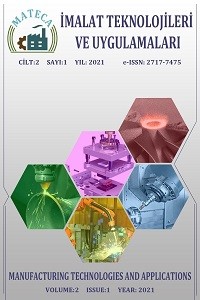Toz Metalurjisi Yöntemi ile WC Takviyeli CuNiSi Kompozitlerin Üretimi ve Karakterizasyonu
Abstract
Teknoloji ve endüstride artan talebe bağlı olarak daha üstün özelliklere sahip malzemelere olan gereksinim her geçen gün artmaktadır. Bu gereksinim ile birlikte bilim adamları yeni ve üstün özelliklere sahip malzeme üretimi için çeşitli çalışmalar yapmaktadırlar. Metal matrisli kompozitler, genel olarak toz metalürjisi yöntemi ile oldukça başarılı bir şekilde üretilmektedirler. Bu çalışmada, toz metalurjisi (TM) yöntemi ile CuNiSi toz karışımına, ağırlıkça farklı oranlarda WC parçacıkları takviyesi yapılarak, kompozit numuneler üretilmiştir. Hazırlanan CuNiSi ve WC toz karışımları 600 MPa basınç altında soğuk preslenerek ham numune haline getirilmiştir. Ham numune haline getirilen numuneler atmosfer kontrollü fırında 900 ℃ sıcaklıkta 1 saat süre ile sinterleme işlemine tabi tutulmuştur. Üretilen numunelerin mikroyapılarını belirleyebilmek için taramalı elektron mikroskobu (SEM-EDS), üretilen numunelerin içyapılarında oluşan fazları belirleyebilmek için X-Işını Kırınım yöntemi (XRD) analizi ve WC parçacıklarının sertlik üzerine etkisini belirleyebilmek amacıyla mikrosertlik (HV0.05) testi yapılmıştır. Mikroyapı sonuçlarından, WC partiküllerinin yapı içerisinde homojen olarak dağıldığı tespit edilmiştir. Üretilen numunelerde artan WC miktarına bağlı olarak sertlik değerlerinde artış olmuştur. Bunun yanısıra, deneyler sonucunda en yüksek sertlik değeri % 10 WC ilave edilen numunede 117 HV0.05 olarak ölçülmüştür.
References
- Referans1: A. Yönetken, Investigation of the production and mechanical properties of silicon carbide-reinforced composites, Iğdır Üniversitesi Fen Bilimleri Enstitüsü Dergisi, 9(3): 1551-1558, 2019.
- Referans2: T. Çetin, M. Akkaş, Effect of WC reinforced on microstructure and mechanical properties of CuAlMn alloys produced by hot pressing method, European Journal of Technique, 10(1): 173-183, 2020.
Production and Characterization of WC Reinforced CuNiSi Composites by Powder Metallurgy Method
Abstract
Due to the increasing demand in technology and industry, the need for materials with superior properties is increasing day by day. With this requirement, scientists carry out various studies for the production of new and superior materials. Metal matrix composites are generally produced very successfully by powder metallurgy method. In this study, composite samples were produced by reinforcing different proportions of WC particles by weight to the CuNiSi powder mixture by powder metallurgy (TM) method. Prepared CuNiSi and WC powder mixtures were turned into raw samples by cold pressing under 600 MPa pressure. The samples that were turned into raw samples were subjected to sintering process in an atmosphere controlled furnace at 900 ℃ for 1 hour. Scanning electron microscopy (SEM-EDS) to determine the microstructure of the samples produced, X-Ray Diffraction method (XRD) analysis to determine the phases formed in the internal structures of the produced samples, and the microhardness (HV0.05) test to determine the effect of WC particles on hardness. From the microstructure results, it was determined that the WC particles were homogeneously distributed in the structure. Due to the increasing amount of WC in the samples produced, there was an increase in the hardness values. Besides, as a result of the experiments, the highest hardness value was measured as 117 HV0.05 in the sample added with 10% WC.
References
- Referans1: A. Yönetken, Investigation of the production and mechanical properties of silicon carbide-reinforced composites, Iğdır Üniversitesi Fen Bilimleri Enstitüsü Dergisi, 9(3): 1551-1558, 2019.
- Referans2: T. Çetin, M. Akkaş, Effect of WC reinforced on microstructure and mechanical properties of CuAlMn alloys produced by hot pressing method, European Journal of Technique, 10(1): 173-183, 2020.
Details
| Primary Language | Turkish |
|---|---|
| Subjects | Composite and Hybrid Materials |
| Journal Section | Research Articles |
| Authors | |
| Publication Date | April 30, 2021 |
| Submission Date | March 5, 2021 |
| Published in Issue | Year 2021 Volume: 2 Issue: 1 |

